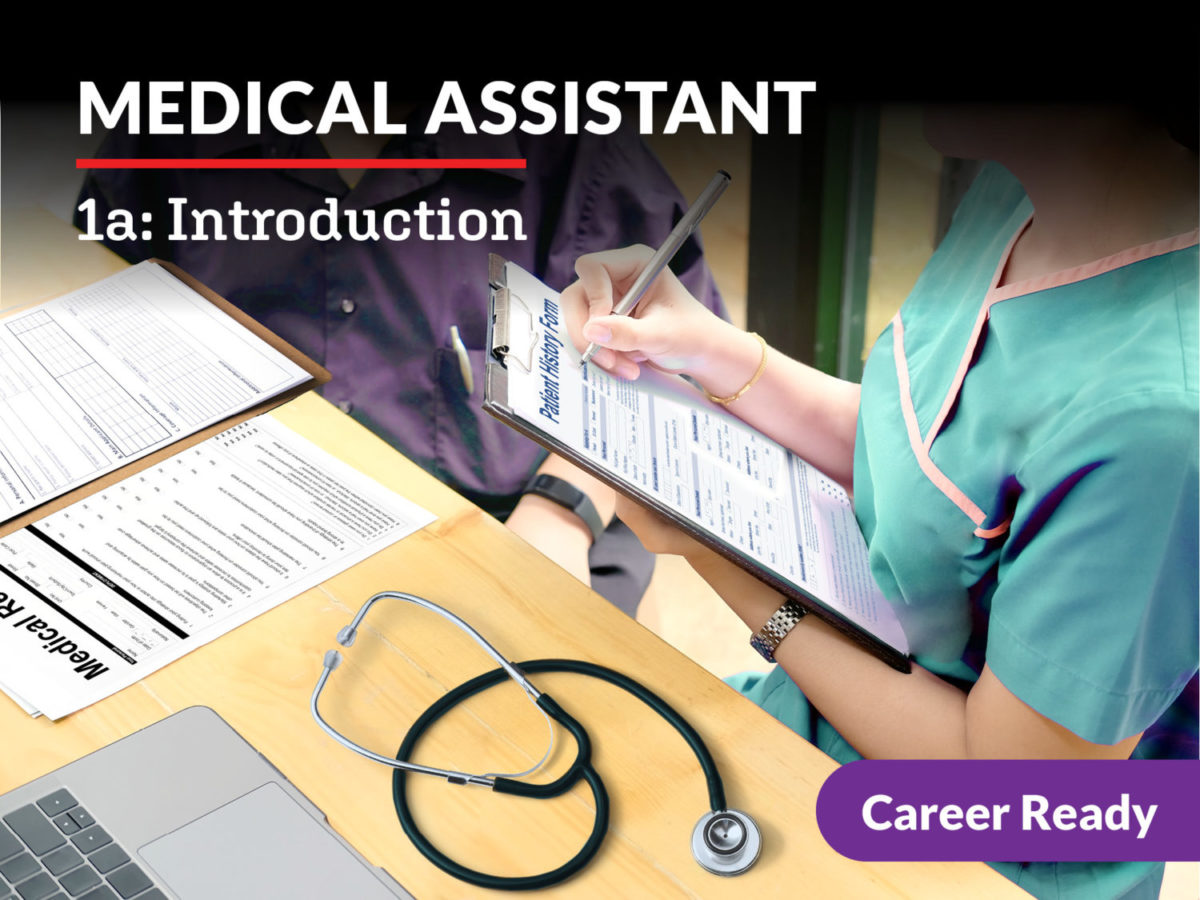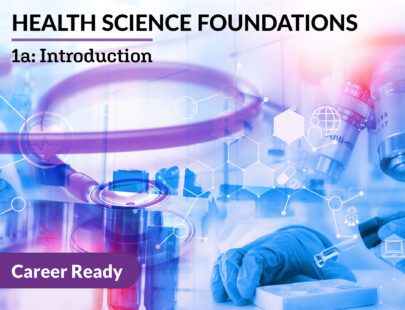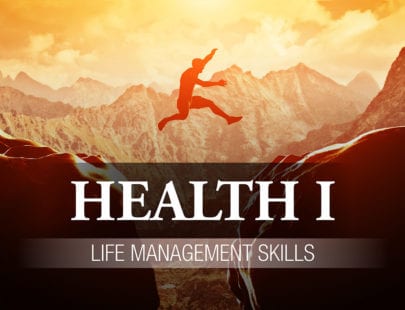
Medical Assistant 1a: Introduction
It takes a strong team to offer top-notch patient care, and each team member plays in integral role. Are you a team player interested in coordinating patient care? Then a career as a medical assistant may be right for you! In this course, you will acquire medical terminology, investigate anatomy and physiology, learn keys to professionalism in an office setting, and explore office roles while building a professional portfolio. Let’s learn what it takes to fill the important shoes of a medical assistant today!
Units at a Glance
Unit 1: Healthcare Services and the Healthcare Team
Have you ever wondered what it takes to care for a patient? We all know what it’s like to see a doctor and get treated, but so much more is going on behind the scenes. The healthcare world consists of a wide variety of professionals who perform roles that are just as diverse. As we explore the history of these services and the roles of the people who make up the healthcare team, we’ll also see the importance of teamwork in accomplishing the common goal of treating the patient. Let’s investigate healthcare services and the healthcare team!
What will you learn in this unit?
- Discuss the history of healthcare services
- Identify the components of the healthcare delivery system
- Name the types of healthcare organizations and give examples of organizations that set the guidelines to oversee them
- Describe the responsibilities of different members of the healthcare team to understand the importance of teamwork
- Outline ways to find, apply for, and interview for a healthcare job and recognize the importance of mental health for healthcare professionals
Unit 2: Learning the Language: Medical Terminology
Have you ever heard medical professionals talking in a doctor’s office or a hospital and had no idea what they were saying? What about the abbreviations they use? How can so little mean so much? The medical world has its own language and to become part of that world, we need to learn that language, speak it, and translate it for our patients. Let’s continue building a firm foundation for medical assisting as we learn the language of medical terminology.
What will you learn in this unit?
- Outline the process for building a medical term and making it plural
- Recognize commonly used prefixes and suffixes
- Define commonly used combining forms by translating conditions, procedures, and instruments
- Identify abbreviations, acronyms, and symbols used in the medical world
- Describe anatomical positions, divisions, and body positions as well as their relationship to body movement
Unit 3: Building Up: Anatomy and Physiology I
Before we learn about the skills that are specific to any medical profession involving patient care, it is essential that we gain an in-depth knowledge of anatomy and physiology. As we review this material, we’ll start with the smallest unit within the body, examine its systems, and identify growth and development patterns and milestones across the life span. Have you ever wondered what keeps all of these processes going? We’ll also look at the role nutrition plays in maintaining health. Let’s build up to staying healthy!
What will you learn in this unit?
- Identify the structural units of the body (e.g., cells, tissues, and organs) and their importance in maintaining homeostasis
- Describe the nutritional needs of the body and how diet may be adjusted to compensate for conditions and disorders
- Outline developmental stages, milestones, and growth patterns in conjunction with the role each plays in patient health education planning
- Recognize the structure and functions of the musculoskeletal system
- Analyze the roles of the integumentary and sensory systems
Unit 4: Take a Deeper Look: Anatomy and Physiology II
We know what we see when we look at someone, but what mysteries lie beneath the surface? As we take a deeper look, we’ll explore systems within the body that perform functions like circulation, respiration, digestion, and sending and receiving nerve impulses. Although each system plays a unique role, we’ll investigate how they work together to maintain homeostasis and create a healthy body.
What will you learn in this unit?
- Identify the structures and functions of the nervous system
- Describe the organs and tissues of the hematopoietic and lymphatic systems
- Recognize the role of the tissues and organs of the cardiovascular system
- Explain the structure and function of the organs of the respiratory system
- Analyze the digestive and urinary systems
- Describe the parts of the reproductive and endocrine systems
Unit 5: When Things Go Wrong: Diseases and Disorders
The way the body’s systems work together to maintain the careful balance of health is truly amazing, but with so many working pieces, sometimes things go wrong. This investigation leads us through the various body systems to determine the causes, signs, and symptoms of common diseases and disorders as well as risk factors and methods of diagnosis and treatment. We’ll also look into the role pathogens play in the spread of disease and ways to prevent them. But, if we don’t consider mental health, we aren’t treating the whole patient, so we’ll also look into the role of psychology in patient care. Come along as we find out what happens when things go wrong!
What will you learn in this unit?
- Describe common pathology of the musculoskeletal and nervous systems
- Investigate issues involving diseases of the sensory, integumentary, and reproductive systems
- Define the digestive, urinary, and endocrine systems
- Demonstrate knowledge of the pathology of the cardiovascular, lymphatic, and respiratory systems
- Identify pathology of the hematopoietic system and how bloodborne pathogens spread disease
- Explain developmental psychology and factors that impact mental health
Unit 6: Professionalism and the Art of Communication
What characteristics make someone a professional? Sure, the educational requirements and additional certifications are part of the equation, but many traits can be mastered before getting to that level! As we explore the keys to effective communication, we’ll also investigate important factors in professionalism as well as the ethical role and responsibility of a healthcare worker. Join me as we decipher the key to professionalism and the art of communication!
What will you learn in this unit?
- Describe verbal and nonverbal communication skills, including special considerations
- Analyze common barriers to communication
- Identify proper handling methods for verbal and written correspondence
- Recognize defense mechanisms and how to handle crucial conversations
- Discuss professionalism and ethical behavior in healthcare settings
Unit 7: Technology in Health Care
Have you ever wondered how healthcare organizations manage the huge amounts of patient information that they ask for and update regularly? The days of paper files and large storage rooms are disappearing as all types of healthcare facilities switch to electronic systems. What considerations come along with utilizing these systems and what types of functions make life easier? We’ll find answers to these questions and more as we explore technology in health care.
What will you learn in this unit?
- Describe similarities and differences between paper-based systems and electronic systems used in health care
- Discuss legal and ethical issues and regulations related to technology in health care
- Identify the contents of medical records and the importance of maintaining them
- Define functions of electronic health records, electronic medical records, and computerized physician order entry systems
- Analyze uses of software and peripheral devices
Unit 8: Front Office Roles
Medical assistants perform many roles in the medical world. In the front office, they serve as the voice and face of the facility, guiding patients as they schedule their appointment, come in for the visit, and leave after seeing the doctor. They likewise help to maintain the waiting room and frequently interact with vendors and other business associates. Together, we’ll investigate what it takes to be a medical assistant in the front office. With so much that could go wrong in this process, we’ll see what goes on behind the scenes to keep everything running smoothly!
What will you learn in this unit?
- Describe methods used to format a schedule for patient appointments
- Identify scheduling considerations
- Recognize methods to manage workflow in a medical environment
- Manage the medical facility environment
- Analyze communication methods and methods of improvement in a medical facility
Required Materials
Physical
- Art supplies
- Audio recording device
- Video recording device
- Camera
Software
- Spreadsheet software
- Word processing software
Optional
- Printer
- Graphic design software
- Presentation software
- Publishing software
- Friend or family member
- Index cards
- Diagrams or illustrations of different body systems



